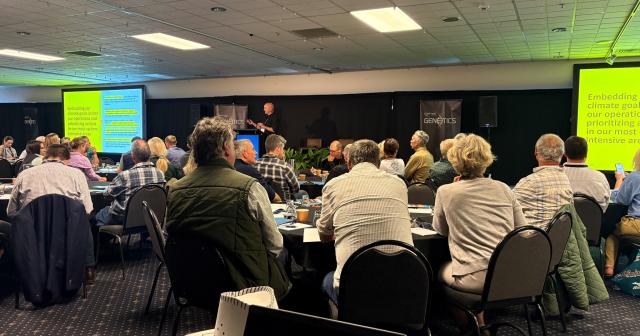Over 150 people attended last week’s Beef + Lamb New Zealand's Beef Breeders Forum where the focus was on the need to drive genetic gain in New Zealand’s beef industry.

Speakers covered a range of topics over the one-day Forum in Christchurch, including innovation in beef genetics, the launch of nProve Beef, the development of NZ-specific breed indexes, the use of AI and precision farming in beef production and cutting-edge technologies in artificial breeding.
B+LNZ’s General Manager Farming Excellence Dan Brier said the Forum provided a platform for industry to come together to address shared concerns and discuss solutions to some of the challenges facing the industry.
“One of the highlights was seeing the level of engagement between stud and commercial breeders representing a range of breeds and breed organisations. We are a small industry, so it is important we all work together to help drive genetic improvement and ensure NZ’s beef industry is well placed to capture future opportunities.”
He told attendees that at just 0.5% per year, NZ’s beef industry was lagging well behind the annual genetic gain made in the dairy industry (1.8 %) and the sheep industry (2.8 %).
Through the seven-year Improving New Zealand Beef (INZB) programme, B+LNZ was helping to speed this rate of genetic gain by improving access and visibility of genetics and genetic tools to commercial farmers and increasing demand for genetically superior animals.
The nProve Beef on-line tool, which was launched at the Forum, was designed to help commercial farmers find beef breeders with aligned breeding objectives.
Based on the successful nProve for sheep, which has been used by 4742 people over 17000 sessions in the past 12 months, nProve Beef is a user-friendly tool and is now available for use in the lead-up to the bull buying season.
In line with the drive to make it easier for commercial beef breeders to make good genetic decisions, Jason Archer, B+LNZ’s Head of Genetics, outlined the drivers behind the development of NZ-specific Selection Indexes
He said bull buying can be too complex, with up to 58 pieces of information about each bull presented to farmers who only buy bulls once a year.
Indexes present one number to buyers and through the INZB programme, B+LNZ has developed three indexes; $Maternal, $Terminal and $Beef on Dairy. Archer says bull buyers still need to know the traits behind each index, hence the development of sub-indexes, or trait groupings. These help buyers understand what a particular bull is good at and include calving ease, maternal cow traits, finishing and carcase attributes.
Simon Kenny, Head of Impact and Communications for McDonald’s restaurants in New Zealand was the keynote speaker at the Beef Breeders Forum. He told the audience that McDonald’s uses 2% of the world’s beef production and beef farming accounted for 35% of the fast-food chain’s total greenhouse gas emissions.
Committed to being net zero by 2050, McDonald’s was striving for a 16% absolute reduction in farm emissions from its global suppliers.
Kenny says they were taking a two-prong approach to reducing farm emissions and this was the use of regenerative agriculture (in whatever form that takes) and an increase in carbon removal, without relying on forestry.
While McDonald’s was working to reduce its greenhouse gas emissions, for its customers, taste, cost and convenience remained the main drivers behind their purchasing decisions, all far more important than sustainable beef production.
Kenny says McDonalds had global drivers that are clearly related to its climate goals which they have to live by. As NZ is a strategically important partner for McDonalds, they want to partner with others, rather than telling farmers what to do, to try and achieve those goals while bringing their customers along on the journey.
“Maybe in five years’ time, when they are eating a Big Mac, they will think a bit more about where it came from and be willing to pay a bit more for it.”